Does a ductless range hood insert need to have open ventilation?
Holly
2 years ago
last modified: 2 years ago
Featured Answer
Sort by:Oldest
Comments (6)
User
2 years agoHolly
2 years agoRelated Discussions
quiet and powerful 36" range hood insert: does your kitchen have one?
Comments (46)Hey folks. We've been using the 36" Zephyr Monsoon DCBL one-piece-liner with the following specs for a few months. We really hesitated to spend this much since our reno is essentially a budget/DIY one, but we are pleased with our purchase. Min.-Max. CFM 250 - 715 Min.-Max. Sones 0.8 - 5.8 Our installation is not ideal as our hood is mounted quite high due for head injury prevention reasons. That contributes to higher noise level and less efficient function. Overall, we are pretty happy with this hood. The hood can't keep up with extreme searing, but we are no longer routinely setting off the smoke alarm :) . It does move a tremendous amount of air at higher settings - at the outdoor vent you can see nearby leaves whipping around. I am satisfied with the noise levels, which was my major concern. At setting 1 (250 CFM) I hear a low hum, which does not annoy me if I am trying to chat or listen to music. That setting is fine for regular cooking and I am getting used to having the fan all the time when using the range. Setting 2 is louder, but still possible to chat or listen to music...and definitely pulls more air. Setting 3 is getting noisy, but I use it for shorter periods when frying bacon, etc. Setting 4 or 5 might suck up one of my children - powerful and loud. I like using Setting 1 when I notice lingering cooking smells after cooking in our large open concept space. The LED lights are pretty good. I like having a high and low setting. I like that all controls are on the underside rather than the front. Also, there are no LED lights when the unit is off (unless the baffles are due for cleaning) - also a plus. I like the feature that shows when the baffles are due to cleaning because I probably would not do this often enough. Previously we used two different builder grade hoods, and there is simply no comparison with the efficiency of suction and the noise levels, so this is a huge upgrade. I was thrilled to get free shipping of the hood to Canada from wayfair.ca. We never get free shipping in Canada!! Unfortunately the unit arrived quite damaged from the shipping process. The box was sturdy but the internal packing was inadequate. We decided to fix it rather than deal with the hassle of getting a remedy....See MoreVentilation Hood Advice: Vent-A-Hood or Miele Insert Liner
Comments (26)I am the resident expert only because real HVAC systems engineers don't frequent this forum, as far as I know. Noise introduced into the kitchen will be significantly reduced if an external blower with silencer can be fitted. A lot of the high frequency blade tip turbulence caused noise will be removed. This is also true of an in-line (duct mounted) blower. The issue of the neighbor is difficult to assess. What is the configuration of his or her windows relative to your potential external blower (1500 CFM I assume you meant). Your own window sound transmission is also an unknown. Generally, the external noise could be abated by (a) using a silencer on each side of a duct mounted in-line blower, or (b), using a deliberately under-driven* "up-blast" commercial blower (mounted as a side blast). (I think opaone is using an under-driven blower for his new system.) It is also possible to use a chase to move the blower up to roof level. I have a 1500 CFM nominal Wolf (Broan) blower on my roof. Its sound level is detectable but not obtrusive from the ground, but it might be if in a wall location where the sound is "trapped" between two houses. Possibly a more expensive but similar in design Abbaka downslope unit would be marginally quieter. ------ * commercial blowers of this type can use a pulley system between motor and fan that allows for different ratios. By choosing a ratio that operates the fan blades below their rated speed when the motor is receiving maximum voltage, significant turbulence noise can be avoided. The physical cost is a larger unit than would otherwise be required for the desired flow rate. Residential blower fans are directly coupled to their motors....See MoreRange hood insert for limited ducting space needed
Comments (11)Shari-- I don't entirely understand your layout/space issue either, but if you can swing a blower that's farther away from the kitchen I'd definitely suggest you give that a strong look. We bought and installed a 42" Zephyr Monsoon vented strait up into the attic and and then at a slight angle to and out the roof, but we found it so aggravatingly loud even on the lowest setting that we replaced it with a Wolf liner, inline silencer and Abbaka roof mounted blower. During this process I downloaded a decibel app to my phone, and the Abbaka setup (1400 cfm) is quieter on high than the Zephyr was on low. Despite the bitter pill of having to buy two ventilation systems, we're very happy we switched. Wolf literature shows the liner is 12" tall, and I'm not understanding why you can't attach an elbow to the top of that that turns where you need it to at 22". Wolf isn't the only maker of liners, so you can shop around--I like the fact that it has a variable speed control rather than pre-sets like the Zephyr, but I've discovered it doesn't have a grease collection reservoir which seems like a strange omission....See MoreDoes a ductless hood need a duct/vent?
Comments (10)Don't expect the hood to draw its anticipated air flow rate if the recirculation exhaust is gagged by a small register. The total area of the register openings should at worst equal the total area of the baffle gaps if the hood uses baffles. (Even that is a significant obstruction -- pressure loss wise.) If the hood uses meshes, then some guess as to the effective area of the mesh should be used instead of baffle gap area.. I would recommend that with the hood system out of its wood cabinet, you observe the apparent flow out of the top with and without the candidate register in the path. The manufacturer should have provided information about what register size is appropriate....See MoreHolly
2 years ago3onthetree
2 years agoHolly
2 years ago
Related Stories
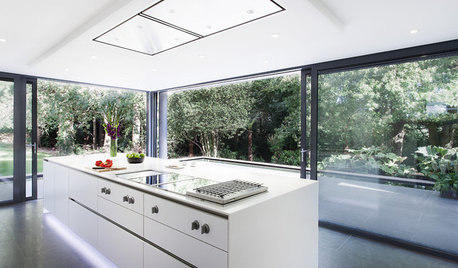
KITCHEN APPLIANCESDisappearing Range Hoods: A New Trend?
Concealed exhaust fans cut visual clutter in the kitchen
Full Story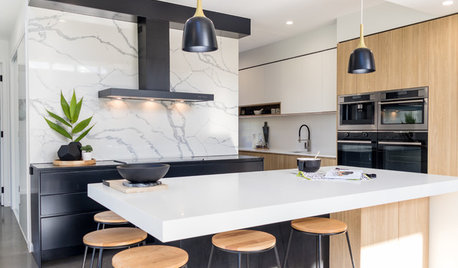
KITCHEN DESIGNHow to Get Your Range Hood Right
Get a handle on the technical specs, and then learn about fun design options for creating a beautiful kitchen feature
Full Story
KITCHEN APPLIANCESWhat to Consider When Adding a Range Hood
Get to know the types, styles and why you may want to skip a hood altogether
Full Story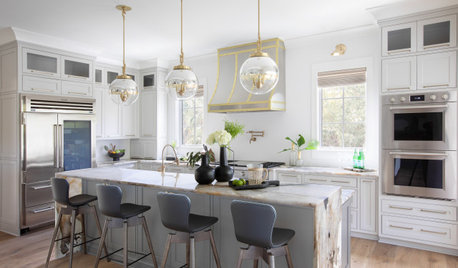
KITCHEN DESIGNDesigner Tips for Range Hoods, Appliances and Lighting
Learn how to get your microwave height just right, what kind of bar stool will be most comfortable and more
Full Story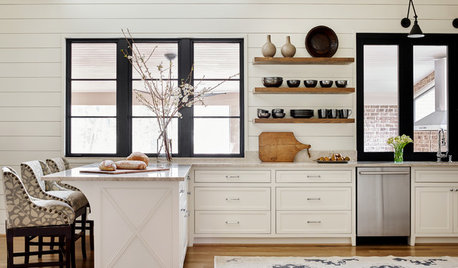
WHITE KITCHENSRoom of the Day: Soothing Kitchen With a Clever Range Hood Hack
Creamy whites and neutral accents keep this kitchen understated. A design trick makes the hood look more expensive
Full Story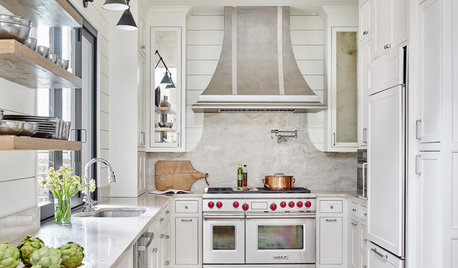
KITCHEN APPLIANCESHouzz Call: Show Us Your Creative Range Hood
Have you customized your kitchen’s range hood? Please tell us all about it
Full Story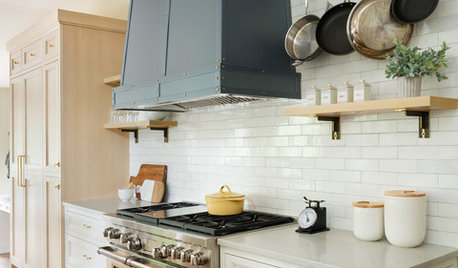
BEFORE AND AFTERS4 Kitchen Makeovers With Standout Range Hoods
In these before-and-afters, see how a custom range hood can take your kitchen renovation to the next level
Full Story
5 Stunning Modern Range Hoods
Today's kitchen range hoods can look like sleek sculptures. Here's what to look for when you go shopping for one
Full Story
INSIDE HOUZZHow Much Does a Remodel Cost, and How Long Does It Take?
The 2016 Houzz & Home survey asked 120,000 Houzzers about their renovation projects. Here’s what they said
Full Story



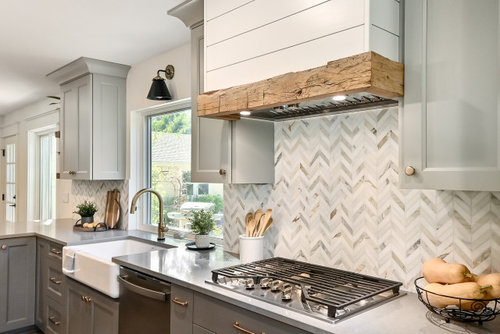

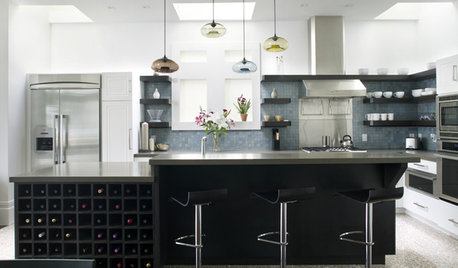
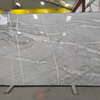
3onthetree